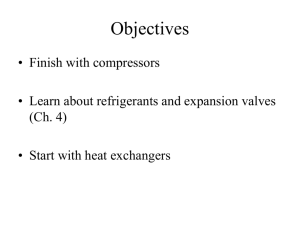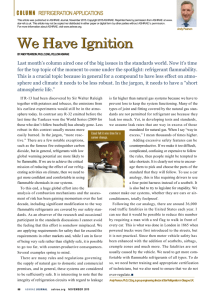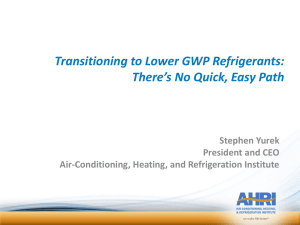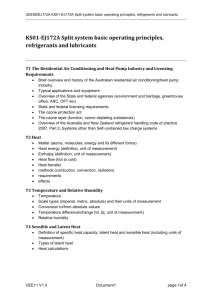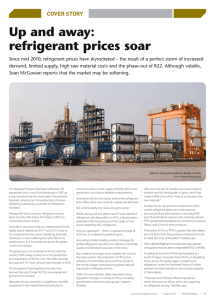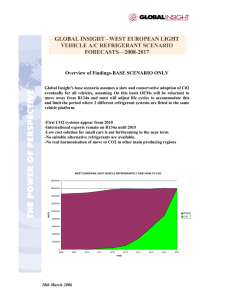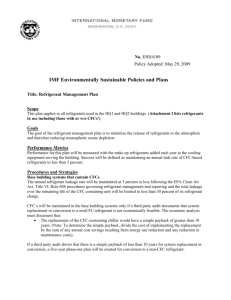April 2009 - Responsible Use of Refrigerants in HVAC
advertisement
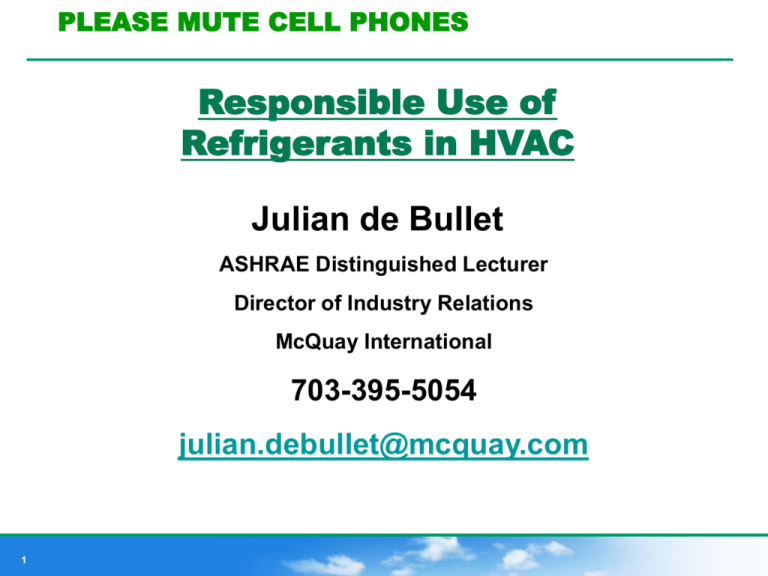
PLEASE MUTE CELL PHONES Responsible Use of Refrigerants in HVAC Julian de Bullet ASHRAE Distinguished Lecturer Director of Industry Relations McQuay International 703-395-5054 julian.debullet@mcquay.com 1 It’s About the World….. Globally the Issues are the Same………. 2 History of Refrigerants • 1830s - Jacob Perkins - Vapor Compression (ether) • 1851 - John Gorie - Patent for Vapor Compression Cycle • 1859 R-717 / R-718 (Ammonia / Water) • 1866 CO2 - Naval Applications • 1873 - R-717 (Ammonia) Commercial Refrigeration Karl Linde • 1875 - R-764 (Sulfur dioxide) • 1920s -R-600a (Isobutane) & R-290 (Propane) • 1922 - Willis Carrier - R-1130 (Dielene) • 1926 - R-30 (Methylene Chloride) 3 Fluorocarbons • CFCs, HCFCs and HFCs HYDROGEN • Limited Combinations Flammable – Adding Chlorine Or Bromine Increases ODP – Adding Fluorine Increases Toxic GWP – Adding Hydrogen Increases Flammability And Lowers Atmospheric Lifetime CHLORINE FLUORINE Long Atmospheric Lifetime (fully halogenated) 4 Ozone Depletion was Detected in the 70’s……….. 5 Refrigerants Circa 1987 • Common HVAC Refrigerants Include CFC-11, CFC-12 (ODP=1.0), HCFC-22 (ODP=0.05) • Chiller Efficiency 0.70-0.80 kW/ton • Low Pressure Chillers Lose 25% Of Charge Annually 6 Montreal Protocol Corrective Measures • HFC-134a (ODP=0) Replaces CFC-12 for Chillers and HCFC-22 for most Commercial HVAC Systems • HCFC-123 (ODP=0.02) Replaces CFC-11 – These Chillers Tightened Up (High Efficiency Purge, Portable Refrigerant Vessels, Blankets etc.) 7 20 years later….Ozone Depletion Continues….. 2005 ‘Hole” was one of largest and deepest ever…. Latest NASA predictions delays recovery until 2068…..nearly 20 years later than previously believed….. 8 9 Montreal Protocol –Changes Made on Friday September 21st, 2007 Consumption Phase Out Schedule – Developed Countries 100% Consumption cap reduced from 35% to 25% in 2010 80% 65% 60% 40% 25% 20% 2015 Service Tail Review 10% 0.5% 0% 1996 2004 2015 2010 2020 2030 Consumption Phase Out Schedule – Developing Countries 100% Freeze 90% 80% 65% 60% 40% Current: Consumption cap steadily reduced starting in 2015 Previous: Consumption capped at 2015 levels until 2040 32.5% 20% 2.5% 0% 2013 2015 2020 2025 2030 2040 Note: acceleration shown in light blue 10 AVAILABILITY OF REFRIGERANT (Dupont & ICI Projections) Tons (000) 300 250 200 HFC134a 150 HCFC22 HFC410A 100 50 0 HCFC123 1995 2000 2005 2010 Year 11 2015 2020 2025 2030 And Don’t Forget HCFC-22 • HCFC-22 phase-out in 2010 for new equipment and 2020 for service tail production – Consider alternatives for HCFCs now • Recommended actions – Select high efficiency units that use zero ozone depleting refrigerants like HFC-410A, HFC-134a and HFC-407C 12 HCFC-22 Issues- Clarification Allow the sale of window air conditioners, packaged terminal air conditioners, and some commercial refrigeration units after Jan. 1, 2010, if they were manufactured before Jan. 1, 2010. Stockpiling of this equipment is allowed under the rule. • Allow the sale of pre-charged appliance components and parts manufactured (in the traditional sense), such as condensing units, line sets, and expansion valves, used for servicing as long as they were manufactured before Jan. 1, 2010. Stockpiling of this equipment is allowed under the rule. • Ban the sale and installation on or after Jan. 1, 2010, of pre-charged R-22 air conditioners (such as split systems) and refrigeration appliances that require field charging. Contractors are advised not to stockpile this equipment. • Permit servicing and repair work that requires the refrigeration loop to be opened and closed. There was a question as to whether this activity would be banned because it could be interpreted as ‘manufacturing’ after the Jan. 1, 2010 deadline.” 13 ASHRAE Standard 34 14 ASHRAE 34 High Flammability Low Flammability No Flame Propagation 15 SAFETY GROUPS A3 B3 Propane Butane A2 B2 R-142b, 152a Ammonia A1 B1 R-11, 12, 22, 114, 500, 134a R-123, SO2 Lower Toxicity Higher Toxicity Application Considerations Refrigerants & Compressors WATER COOLED CHILLER DUTY 18 32 POSITIVE DISPLA CEMENT, ROTA RY, SCROLL, RECIP, SCREW 16 152a DELTA H, (Btu/lb) 14 410A 12 134 22 10 11 134a 143a 507 502 125 8 6 500 123 124 12 113 114 4 CENTRIFUGA L 2 0 .1 1 10 CFM/TON 16 100 REFRIGERANT TRANSITION SO2 -NH3 1920s toxic flammable 17 CFCs HCFCs HFCs 1930s-1990s 1950s-2010s 1990s + high chlorine lower chlorine no chlorine strong ozone depletion lower ozone depletion zero ozone depletion strong global warming lower global warming lower global warming •1974 – Molina-Rowland theory •1987 – Montreal protocol •1990 – CAA amendments •1996 – total phaseout of CFCs •2010 - phaseout of HCFC-22 for new equipment •2020 - total phaseout of HCFC-22 and New HCFC -123 chillers. ASHRAE Standard 15 18 ASHRAE Standard 15 What is ASHRAE 15? An industry standard that specifies safe design, construction, installation, and operation of refrigerating systems Establishes safeguards for life, limb, health, and property, and prescribes safety standards 19 Mechanical Room Safety Check: Location of inlet vents in relation to exhaust outlets ? Purge vents to outside ? Location of roof drains ? Rupture disc outlet locations ? Is there a tight seal on doors ? Are safety rupture lines the right size ? Is access to mechanical room restricted ? Are drain valves connected to evacuation devices ? Are there any pit areas in the room ? 20 Where do the floor drains empty to ? Mechanical Room Per ASHRAE 15 Purge systems and relief devices must be vented to outside (8.16) Relief discharge shall be located not less than 20 ‘ from ventilation opening and not less than 15’ above ground level (9.7.8) All indoor machinery rooms must be vented to the outdoors utilizing mechanical ventilation 98.13.3 & 4 Access to mechanical room shall be restricted. Tight fitting doors opening outward (self closing if the open into the building) adequate in number to ensure freedom of escape. No other openings that would permit passage of escaping refrigerant (8.13) Refrigerant sensors are located in areas where refrigerant vapor from a leak will be concentrated so as to provide warning at concentration not exceeding the refrigerant TLV-TWA 21 The total amount of refrigerant stored in a machinery room in all containers not provided with relief valves & piped in accordance with standard shall not exceed 330 lb.. (11.5) What About GWP and Leakage Rates? For chillers, (Indirect) global warming gas emissions (CO2) at the power plant account for more than 96% of the Total Equivalent Warming Impact Oak Ridge National Laboratory (AFEAS/DOE) Energy and Global Warming Impacts of HFC Refrigerants and Emerging Technologies Nov 1997 Number of Leaks Detected per Unit 23 Climate Change & HFC Refrigerants GWP (Relative to CO 2) Global Warming Potential (GWP) of Key Refrigerants 12000 10000 8000 6000 4000 2000 0 R-22 R-12 R-134a R-404A R-407C Refrigerants • • 24 R-410A R-507A 1 kg R-12 = 10,600 kg CO2 1 kg R-134a = 1,430 kg CO2 1 kg R-410A = 2,088 kg CO2 1 kg R-404A = 3,922 kg CO2 GWP=How much a given mass of GHG contributes to global warming HFC emissions covered under the Kyoto Protocol – Represent less than 2% of all GHG emissions Climate Initiatives Waxman/Markey House Bill- Energy Efficiency • The goal would be for the model building energy codes to be updated every three years to reduce building energy consumption by 30% such target to be increased to 50% incremental reductions in building energy consumption for new code editions released after January 1, 2016, with the ultimate goal being “net-zero-energy” buildings. • The starting baselines would be the 2004 IECC and ASHRAE Standard 90.1-2004. 25 Climate Initiatives Waxman/ Markey Bill- Climate – The Draft provides for an HFC regulatory program under the Title VI of the Clean Air Act, and as expected, provides for (1) a cap and reduction schedule, (2) allocations to HFC Producers, Users and Importers (both bulk and products-containing); and several other provisions – The Draft proves for an initial cap in 2012 that is based on the average of 2004-2006 production (and 100% of HFC and HCFC production). The number is then to be reduced by 6% in the first year, and then 3% each year until 2028. EPA is given authority to set this baseline within the bounds of 380 and 280 MMTCO2e 26 Total Equivalent Warming Impact (TEWI) • TEWI - Tool to estimate global warming impact of various technologies • TEWI estimates CO2 emissions of a given system over its lifetime – Direct: equivalent CO2 emissions caused by direct leakage or loss of refrigerant – Indirect: CO2 emissions due to energy consumption by the system 27 TEWI – Major Findings TEWI - Residential Central Air Conditioners TEWI (MT CO2/Year) 80.00 60.00 13.9% Direct CO2 emissions A/C Metric Tons 40.00 20.00 6% 86.1% Indirect CO2 emissions A/C Metric Tons 94% 0.00 1 1970 2 2006 Year • • 28 New products have half the carbon footprint than products manufactured 35 years ago Energy efficiency is key to reducing greenhouse gas emissions from HVACR equipment Ohnishi Basis for ICCP/TEAP report 29 ARI Standard 550/590 Chiller Certification and IPLV 30 The Industry ARI Standard Part Load Analysis (IPLV) % Load 100 75 50 25 % Hrs 1 42 45 12 Systems Solution Historic Energy Improvements 10 State of the Art IPLV 9 Efficiency (COP) 8 State of the Art Full Load 7 Ave rage IPLV 6 Ave rage Full Load 5 4 1990 1994 1998 2002 Ye ar http://www.unep.org/ozone/Teap-Reports/teap_chiller_report_May2004.pdf 32 Full Load Vs. Annual Load Chiller 58% Fans 24% Pumps 13% Design Performance 33 Chiller 33% Fans 43% Tower 5% Pumps 22% Annual Energy Usage Tower 2% ASHRAE Standard 147 Reducing the Release of Halogenated Refrigerants from HVAC & R Systems • Replaces Guideline 3 • Includes HFC Refrigerants New Initiatives • ARI- Responsible Use Guideline for Minimizing Fluorocarbon Emissions in Manufacturing Facilities 34 Other Refrigerants • R-718 Water • R-717 Ammonia • R-744 CO2 • R-290,600,600a (Propane, Butane, Isobutane) • R-407c • R-410a 35 Natural Refrigerants - Water R-718 • Refrigerant In Absorption Chillers • Safe, Abundant, Environmentally Friendly • COP = 1 (Centrifugal COP = 6.4) • Current Energy Rates Offer Poor Life Cycle Analysis In America • Common In Japan 36 Natural Refrigerants - Ammonia R-717 • Higher Toxicity And Lower Flammability (B2) • Environmentally Friendly • Efficient • Special Safety Efforts Required (Std 15) • Guarded Plants European Built Ammonia A/C Chiller 37 IIAR 2 38 Refrigerants • • • • 39 CO2 R-245fa Hydrocarbons Water Flammable Refrigerants • Propane And Butane • Major Safety Concerns • +35% Domestic Market In N. Europe • 8% Domestic World Market • Not Popular In North America 40 Compression • Best Performance And Lowest Cost Always Starts With Compression • Refrigerant Choice Drives Compressor Design • Examples – Magnetic Bearing – High Speed Synchronous DC Motors – DC Rotary And Scroll Compressors (Japanese Technology) – Inverter Technology 41 Synchronous brushless DC motor Magnetic Brgs AHRI CFC Chiller Task Force • Most recent estimate: 27,000 CFC chillers still in N.A. • Summit of AHRI and Efficiency Advocates- ACEEE, ASE, Utilities etc • Plan to use Stimulus moneys to replace CFC chillers • Three targets – Federal Buildings – State and Local Government Buildings – Commercial Buildings • Plan: – Gain consensus – Develop communication piece – e.g. CFC chillers at 0.9 kw/ton vs 0.56 kw/ton or 90.1- 2010 standards – Write legislative language to finance using Stimulus funds 42 Considerations when Replacing or Retrofitting • Difficulties in Servicing and Maintaining Existing HCFC Equipment. • Declining Availability of HCFC Refrigerants. • Adequate Life-Cycle Timeframes for New Equipment using HCFC’s. • Determining the Remaining Life-Cycle of Existing Equipment. • Understanding Alternative Equipment, Refrigerant Options and Compatibility of Both Refrigerants and Equipment. • Containment is Key…………… 43 Steps we can take today • To have sustainable HVAC solutions – Need to focus on overall global impact – No one solution works for everyone • A focus on components alone – Limited by efficiency of individual components – Need to look at the performance of the system • A focus on refrigerants alone – May increase energy consumed (indirect effect) – HFC’s are a good solution today • Focus on overall impact of building – Reduce leaks in system – Increase energy efficiency through performance standards 44 Innovative Technology Award Innovative Design Award 45 It’s about the NEXT GENERATION……. THANK YOU……… 46

